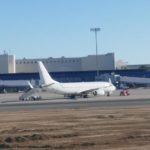Boeing and partners in industry and government achieved significant reductions in fuel consumption and carbon dioxide emissions during a recent deployment of an innovative Air Traffic Management (ATM) concept called Tailored Arrivals.
Seattle – From Dec. 4, 2007 to March 23, 2008, United Airlines, Air New Zealand and Japan Airlines completed 57 flights into San Francisco International Airport that utilized a continuous descent rather than a series of level segments as now required. The Tailored Arrivals approach reduced fuel consumption during descents by up to 39 percent, depending on airplane type, and total carbon emissions by more than 500,000 pounds.
„Concepts like Tailored Arrivals potentially can be deployed quickly and at relatively low cost because the technology is in place today,“ said Kevin Brown, Boeing vice president and general manager of Air Traffic Management. „As more airlines and airports use it, we move closer toward realizing the benefits expected from the Next-Generation Air Transportation System (NextGen).“
Tailored Arrivals enable aircraft to fully utilize air-to-ground data link technology to descend into an airport with minimal direct air traffic control (ATC) intervention. The project relied on key technologies supplied by the U.S. Federal Aviation Administration (FAA) and by NASA. The FAA’s Ocean 21 system delivers data to and streamlines communications between flight crews and air traffic controllers. NASA’s En-route Descent Adviser (EDA) computes fuel-efficient descent solutions.
The airlines involved in the San Francisco flights used Boeing 777-200ER and 747-400 airplanes. On average, full Tailored Arrival approaches reduced fuel consumption of the 777s by 1,303 pounds per flight, or about 34 percent. For the 747s, the savings was 2,291 pounds, or about 39 percent.
Even partial use of the Tailored Arrivals approach, which occurred on 119 additional flights, produced fuel savings of 379 pounds per flight for the 777s and 1,100 pounds per flight for the 747s.
The San Francisco effort began as a development project between Boeing and NASA and continues in partnership with the FAA. It also is part of an international program to reduce fuel consumption and carbon emissions.
The Tailored Arrivals procedures will be used later this year at Miami International Airport as part of a joint FAA-European Commission initiative to accelerate the practical implementation of transatlantic air traffic management improvements that can reduce emissions and noise.
Photo: Boeing





